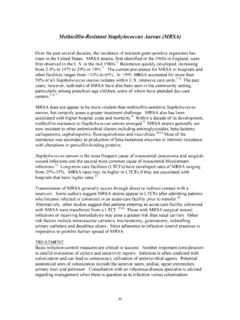Transcription of Sexually Transmitted Diseases Treatment Guidelines, 2015
1 Please note: An erratum has been published for this issue. To view the erratum, please click here. Morbidity and Mortality Weekly Report Recommendations and Reports / Vol. 64 / No. 3 June 5, 2015. Sexually Transmitted Diseases Treatment Guidelines, 2015. Department of Health and Human Services centers for disease control and prevention Recommendations and Reports CONTENTS CONTENTS (Continued). Gonococcal 60. Diseases Characterized by Vaginal 69. Clinical prevention Bacterial 69. Special 72. Emerging 17 Vulvovaginal 75. Hepatitis 17 Pelvic Inflammatory 78. Mycoplasma 20 82. HIV Infection: Detection, Counseling, and 21 Human Papillomavirus 84.
2 Diseases Characterized by Genital, Anal, or Perianal 25 Anogenital 86. 26 HPV-Associated Cancers and 90. Genital HSV 27 Viral 94. Granuloma Inguinale (Donovanosis).. 32 Hepatitis 94. Lymphogranuloma 33 Hepatitis 95. 34 Proctitis, Proctocolitis, and Management of Persons Who Have a History of Penicillin 49 Ectoparasitic Diseases Characterized by Urethritis and 51 Pediculosis 51 Nongonococcal 52 Sexual Assault and Abuse and 53 Chlamydial 55 Terms and Abbreviations Used in This The MMWR series of publications is published by the center for Surveillance, epidemiology , and Laboratory Services, centers for disease control and prevention (CDC), Department of Health and Human Services, Atlanta, GA 30329-4027.
3 Suggested citation: [Author names; first three, then et al., if more than six.] [Title]. MMWR Recomm Rep 2015;64(No. RR-#):[inclusive page numbers]. centers for disease control and prevention Thomas R. Frieden, MD, MPH, Director Harold W. Jaffe, MD, MA, Associate Director for Science Joanne Cono, MD, ScM, Director, Office of Science Quality Chesley L. Richards, MD, MPH, Deputy Director for Public Health Scientific Services Michael F. Iademarco, MD, MPH, Director, center for Surveillance, epidemiology , and Laboratory Services MMWR Editorial and Production Staff (Serials). Sonja A.
4 Rasmussen, MD, MS, Editor-in-Chief Martha F. Boyd, Lead Visual Information Specialist Charlotte K. Kent, PhD, MPH, Executive Editor Maureen A. Leahy, Julia C. Martinroe, Christine G. Casey, MD, Editor Stephen R. Spriggs, Visual Information Specialists Teresa F. Rutledge, Managing Editor Quang M. Doan, MBA, Phyllis H. King David C. Johnson, Lead Technical Writer-Editor Terraye M. Starr, Information Technology Specialists Rachel J. Wilson, Project Editor MMWR Editorial Board William L. Roper, MD, MPH, Chapel Hill, NC, Chairman King K. Holmes, MD, PhD, Seattle, WA. Matthew L. Boulton, MD, MPH, Ann Arbor, MI Timothy F.
5 Jones, MD, Nashville, TN. Virginia A. Caine, MD, Indianapolis, IN Rima F. Khabbaz, MD, Atlanta, GA. Jonathan E. Fielding, MD, MPH, MBA, Los Angeles, CA Patricia Quinlisk, MD, MPH, Des Moines, IA. David W. Fleming, MD, Seattle, WA Patrick L. Remington, MD, MPH, Madison, WI. William E. Halperin, MD, DrPH, MPH, Newark, NJ William Schaffner, MD, Nashville, TN. Recommendations and Reports Sexually Transmitted Diseases Treatment Guidelines, 2015. Prepared by Kimberly A. Workowski, MD1,2. Gail A. Bolan, MD1. 1 Division of STD prevention National center for HIV/AIDS, Viral Hepatitis, STD, and TB prevention 2 Emory University, Atlanta, Georgia Summary These guidelines for the Treatment of persons who have or are at risk for Sexually Transmitted Diseases (STDs) were updated by CDC after consultation with a group of professionals knowledgeable in the field of STDs who met in Atlanta on April 30 May 2, 2013.
6 The information in this report updates the Sexually Transmitted Diseases Treatment Guidelines, 2010 (MMWR Recomm Rep 2010;59 [No. RR 12]). These updated guidelines discuss 1) alternative Treatment regimens for Neisseria gonorrhoeae;. 2) the use of nucleic acid amplification tests for the diagnosis of trichomoniasis; 3) alternative Treatment options for genital warts;. 4) the role of Mycoplasma genitalium in urethritis/cervicitis and Treatment -related implications; 5) updated HPV vaccine recommendations and counseling messages; 6) the management of persons who are transgender; 7) annual testing for hepatitis C in persons with HIV infection; 8) updated recommendations for diagnostic evaluation of urethritis; and 9) retesting to detect repeat infection.
7 Physicians and other health-care providers can use these guidelines to assist in the prevention and Treatment of STDs. Introduction on the basis of their expertise in the clinical management of STDs. Members of the multidisciplinary workgroup included The term Sexually Transmitted Diseases (STDs) refers to representatives from federal, state, and local health departments;. a variety of clinical syndromes and infections caused by public- and private-sector clinical providers; clinical and basic pathogens that can be acquired and Transmitted through sexual science researchers; and numerous professional organizations.
8 Activity. Physicians and other health-care providers play a All workgroup members disclosed potential conflicts of interest;. critical role in preventing and treating STDs. These guidelines several members of the workgroup acknowledged receiving for the Treatment of STDs are intended to assist with that effort. financial support for clinical research from commercial Although these guidelines emphasize Treatment , prevention companies. All potential conflicts of interest are listed at the strategies and diagnostic recommendations also are discussed. end of the workgroup member section.
9 This document updates CDC's Sexually Transmitted Diseases In 2012, CDC staff and workgroup members were charged Treatment Guidelines, 2010 (1). These recommendations should with identifying key questions regarding Treatment and be regarded as a source of clinical guidance rather than prescriptive clinical management that were not addressed in the 2010. standards; health-care providers should always consider the STD Treatment Guidelines (1). To answer these questions clinical circumstances of each person in the context of local disease and synthesize new information available since publication of prevalence.
10 These guidelines are applicable to any patient-care setting the 2010 Guidelines, workgroup members collaborated with that serves persons at risk for STDs, including family-planning CDC staff to conduct a systematic literature review using clinics, HIV-care clinics, correctional health-care settings, private an extensive MEDLINE database evidence-based approach physicians' offices, Federally Qualified Health Centers (FQHCs), ( , using published abstracts and peer-reviewed journal and other primary-care facilities. These guidelines focus on Treatment articles). These reviews also focused on four principal outcomes and counseling and do not address other community services and of STD therapy for each individual disease or infection: interventions that are essential to STD/HIV prevention efforts.















